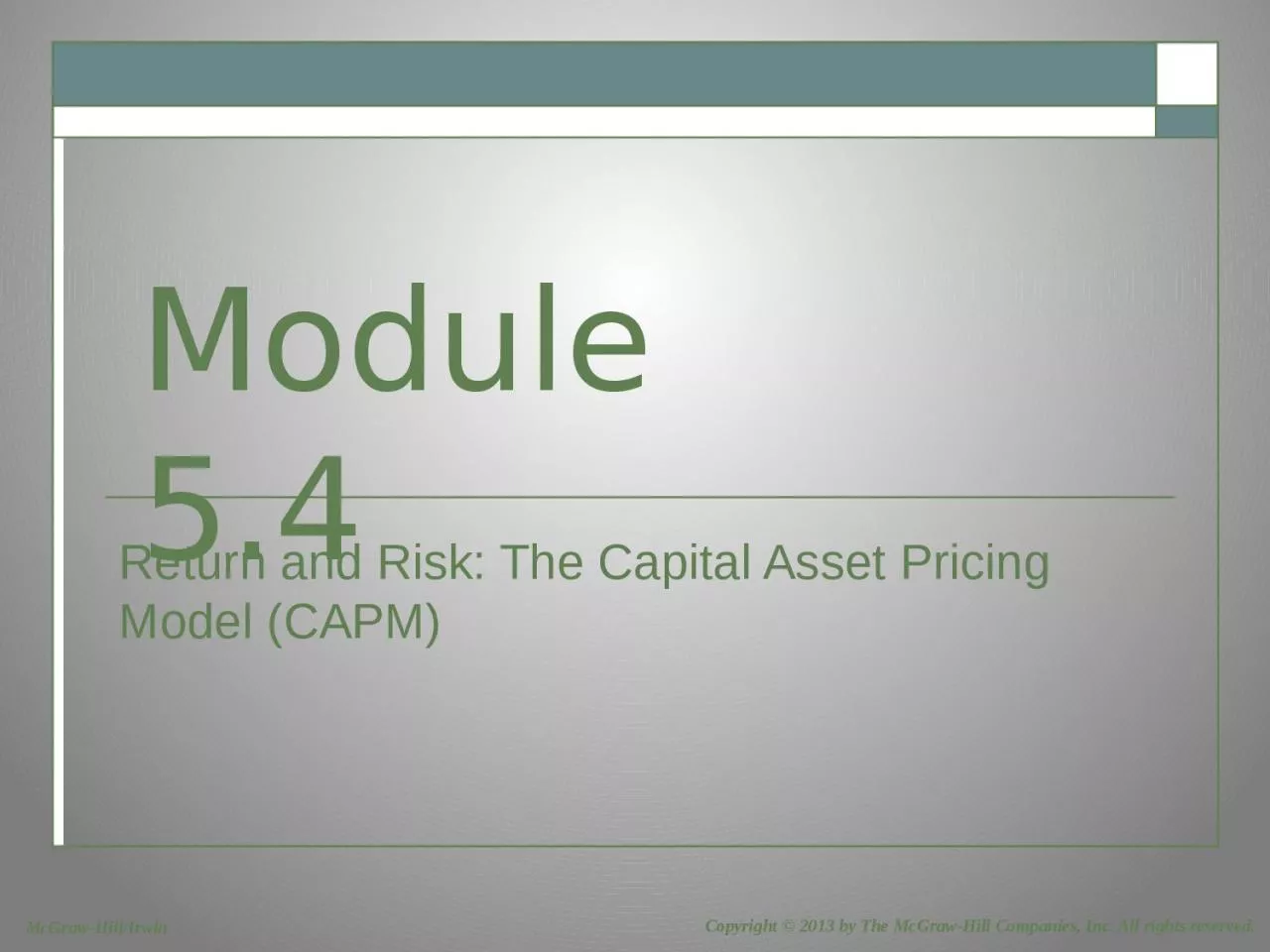

Module 54 Equilibrium risk pricing Modules 2 and 3 largely followed the work of Markowitz Module 4 follows the work of Sharpe Sharpe was going after a holy grail of finance He was trying to figure out how to identify overpriced and ID: 1029561
Download Presentation The PPT/PDF document "Return and Risk: The Capital Asset Prici..." is the property of its rightful owner. Permission is granted to download and print the materials on this web site for personal, non-commercial use only, and to display it on your personal computer provided you do not modify the materials and that you retain all copyright notices contained in the materials. By downloading content from our website, you accept the terms of this agreement.
1. Return and Risk: The Capital Asset Pricing Model (CAPM)Module 5.4
2. Equilibrium risk pricingModules 2 and 3 largely followed the work of Markowitz.Module 4 follows the work of Sharpe. Sharpe was going after a “holy grail” of finance. He was trying to figure out how to identify over-priced and under-priced stocks in a world where everyone could be well-diversified.Both Markowitz and Sharpe won Nobel Prizes for their work
3. A key CAPM assumptionA key simplifying assumption that Sharpe uses is “homogeneous expectations.” This means all investors agree on the expected return, and risk of every asset, and agree on how each pair of assets will be correlated in the future! In essence, we are all sort of like robots that see the world in exactly the same manner.Sharpe knows this is really not true, and in fact, is able to price risk by identifying exactly when we would stop acting “robotic” and choose to overweight or underweight a particular asset.
4. 11.8 Market Equilibrium In a world with homogeneous expectations, M is the same for all investors. With the capital allocation line identified, all investors choose a point along the CML line—some combination of the risk-free asset and the market portfolio M. returnPefficient frontierrfMCML
5. Market EquilibriumWhere the investor chooses along the Capital Market Line depends on his or her risk tolerance. The big point is that all investors have the same CML.100% bonds100% stocksrfreturnBalanced fundCML
6. Risk When Holding the Market PortfolioIf everyone is holding a large market portfolio, then Sharpe showed that beta (b) is the risk inherent in the security that is priced. Beta measures the responsiveness of a security to movements in the market portfolio (i.e., beta is a measure of systematic risk).
7. BetaYou might recognize that expression for beta from your stats class.Covariance(a,b)/Variance (b) = slope of an ordinary least squares regression of a on b.This is why it was quickly named ‘beta’ by financiers and statisticians.
8. Estimating b with RegressionSecurity ReturnsReturn on market %Ri = a i + biRm + eiSlope = biCharacteristic Line
9. The Formula for BetaClearly, your estimate of beta will depend upon your choice of a proxy for the market portfolio.
10. 11.9 Relationship between Risk and Expected Return (CAPM)Expected Return on the Market:Expected return on an individual security:Market Risk PremiumThis applies to individual securities held within well-diversified portfolios.
11. Expected Return on a SecurityThis formula is called the Capital Asset Pricing Model (CAPM):Assume bi = 0, then the expected return is RF.Assume bi = 1, thenExpected return on a security=Risk-free rate+Beta of the security×Market risk premium
12. Relationship Between Risk & ReturnExpected returnb1.0
13. Relationship Between Risk & ReturnExpected returnb1.5
14. Using beta (1)Suppose, using the previous example, that the security was actually priced to yield 12%.In this case the asset is priced to high. People should sell the asset until its price falls to a point where it would now expect to yield 13.5%Suppose, using the previous example, that the security was actually priced to yield 15%.In this case the asset is priced to low. People should buy the asset until its price rises to a point where it would now expect to yield 13.5%
15. Using beta (2)Suppose manager A is charged to manage a small-cap stock fund with portfolio beta of 1.6, and manager B is charged to manage a large-cap stock fund with portfolio beta 1.1. Also suppose the risk-free rate = 4% and market return=10%. The managers can only pick stocks within their respective sub-sets of small (manager A) and large (manager B) stocks.If manager A actually earned 15% and manager B earned 12.5%, which manager did better?“A” should have earned .04+1.6(.06)=13.6%“B” should have earned .04+1.1(.06)=10.6%A’s excess return or “alpha” = 1.4%B’s excess return or “alpha” = 1.9%We would say that manager B did better! Manager B had the greater “risk-adjusted” return.
16. Conclusion of risk pricingCAPM is the first modern attempt to price risk. It employs one-factor called “market risk” and a stock’s quantity of market risk is measured with beta.There are several other risk-pricing models in use today that employ more than one factor. These belong to a family of “multi-factor” pricing models.A topic of FINC852 “Investment Management”